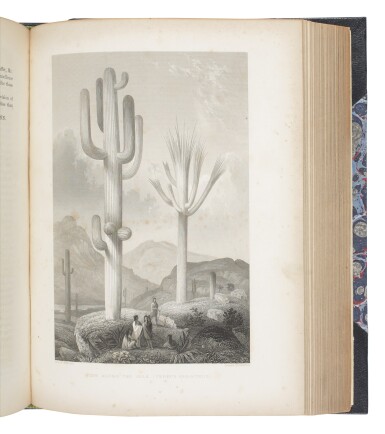Property from a Distinguished Private CollectionEMORY, WILLIAM H.Map of Texas and the Countries Adjacent: Compiled in the Bureau of the Corps of Topographical Engineers, from the Best Authorities, for the State Department, Under the direction of Colonel J.J. Abert, Chief of the Corps. [Washington:] Published by the War Department by order of the U.S. Senate., 1844 Engraved map (21 3/4 x 33 1/4 in.; 544 x 845 mm), engraved by William J. Stone Texas outlined in red. Handsomely framed and glazed with UVIII Plexiglass. The first separate United States Government map of Texas, made for the use of the Senate during the negotiations for the annexation of Texas. The purpose of the map was to show the extent and position of Texas, and its relationship to the neighboring regions of Mexico and the United States. The Republic's boundaries were shown according to the claims of the Texas Congress in 1836. The Rio Grande forms the southern and western boundary for its entire extent, which then runs due north to the 42nd parallel just southeast of the South Pass. The Republic of Texas is therefore shown as including portions of the present states of New Mexico, Colorado, Wyoming, and Oklahoma. This was highly important, since the official status of the map signaled for the first time that when annexation took place, the United States intended to press for the full extent of the Texas territorial claims against Mexico. Emory based his geography on the best sources available at the time; the map cites fifteen "Authorities"—ranging from Alexander von Humboldt's 1803 researches in New Spain to Kennedy's 1843 map of Texas—but is chiefly indebted to Arrowsmith's 1841 map of Texas. Martin and Martin call this "probably the best map of the region at the time of annexation" and note that the "rivers in Texas and coastline were shown in clear detail, while numerous small towns in East Texas were placed and named." Because the results of Fremont's groundbreaking expedition of 1843–1844 had not yet been published, Emory had to rely on earlier sources for his depiction of the Great Basin and the central Rockies, including C. St. Vrain. The northern Great Plains is occupied by a "Proposed Nebraska Territory," and the various native nations are carefully identified in the Indian Territory. The present example is from the larger of two sizes of the map that were issued; no priority between the formats has been established. REFERENCE:Martin & Martin 33; Rumsey 0262; Streeter, Texas, 1543; Wheat, Transmississippi 478Condition ReportCondition as described in catalogue entry. The lot is sold in the condition it is in at the time of sale. The
Property from a Distinguished Private CollectionEMORY, WILLIAM H.Map of Texas and the Countries Adjacent: Compiled in the Bureau of the Corps of Topographical Engineers, from the Best Authorities, for the State Department, Under the direction of Colonel J.J. Abert, Chief of the Corps. [Washington:] Published by the War Department by order of the U.S. Senate., 1844 Engraved map (21 3/4 x 33 1/4 in.; 544 x 845 mm), engraved by William J. Stone Texas outlined in red. Handsomely framed and glazed with UVIII Plexiglass. The first separate United States Government map of Texas, made for the use of the Senate during the negotiations for the annexation of Texas. The purpose of the map was to show the extent and position of Texas, and its relationship to the neighboring regions of Mexico and the United States. The Republic's boundaries were shown according to the claims of the Texas Congress in 1836. The Rio Grande forms the southern and western boundary for its entire extent, which then runs due north to the 42nd parallel just southeast of the South Pass. The Republic of Texas is therefore shown as including portions of the present states of New Mexico, Colorado, Wyoming, and Oklahoma. This was highly important, since the official status of the map signaled for the first time that when annexation took place, the United States intended to press for the full extent of the Texas territorial claims against Mexico. Emory based his geography on the best sources available at the time; the map cites fifteen "Authorities"—ranging from Alexander von Humboldt's 1803 researches in New Spain to Kennedy's 1843 map of Texas—but is chiefly indebted to Arrowsmith's 1841 map of Texas. Martin and Martin call this "probably the best map of the region at the time of annexation" and note that the "rivers in Texas and coastline were shown in clear detail, while numerous small towns in East Texas were placed and named." Because the results of Fremont's groundbreaking expedition of 1843–1844 had not yet been published, Emory had to rely on earlier sources for his depiction of the Great Basin and the central Rockies, including C. St. Vrain. The northern Great Plains is occupied by a "Proposed Nebraska Territory," and the various native nations are carefully identified in the Indian Territory. The present example is from the larger of two sizes of the map that were issued; no priority between the formats has been established. REFERENCE:Martin & Martin 33; Rumsey 0262; Streeter, Texas, 1543; Wheat, Transmississippi 478Condition ReportCondition as described in catalogue entry. The lot is sold in the condition it is in at the time of sale. The















Try LotSearch and its premium features for 7 days - without any costs!
Be notified automatically about new items in upcoming auctions.
Create an alert